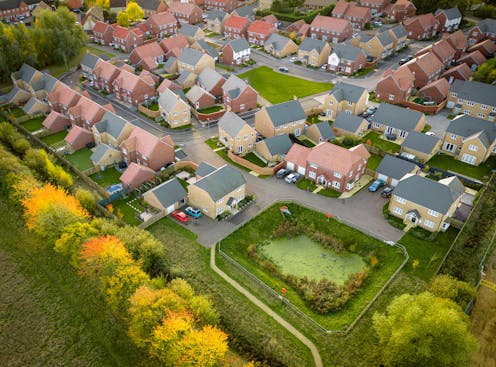Why building new towns isn’t the answer to the UK’s housing crisis
- Written by Amrita Kulka, Assistant Professor, Political Economy and Public Economics, University of Warwick

The UK’s new government is intent on building 1.5 million homes[1] over the next five years. It’s all part of the plan to address the housing supply and affordability crisis.
Many of these homes are to be built in the form of large communities or new towns[2] of more than 10,000 housing units each. Some English new towns built after the second world war, such as Milton Keynes, Harlow and Basildon, have been successful economically. But the building of new towns has ground to a halt since the 1990s.
The importance of large developments for housing supply in the UK has increased dramatically in the last 25 years. We have put together new evidence[3] that reveals a significant shift in the source of housing supply. These days, an increasing share of new homes are coming from large developments.
At the turn of the century, very large developments of at least 500 units made up only single digits of the total percentage of potential housing supply. Today, such developments represent 38% of permitted housing units. These very large projects only made up 0.2% of applications over the 25 years, but make up a disproportionately large chunk of new housing supply.
This graphic shows the share of permitted new homes from 2000 to 2023 for applications of different development sizes across the UK.
Proportion of new homes by development size
Our research[4], undertaken with the support of our research assistant Alex Gallagher[5], explores the barriers that developments face in terms of paperwork and waiting time for a decision. We show that the amount of paperwork increases dramatically with the size of the project, going from one application for projects involving one unit, to more than eight applications for projects involving 500 or more units.
The additional paperwork is generated by things like environmental surveys, infrastructure needs and public utilities.
Northstowe[6] in Cambridgeshire, which was planned to be the largest new town since Milton Keynes was built in the 1960s, also required funding for local infrastructure. Developers were obliged to contribute more than £120 million, most of which went to the construction of local schools. The development was left in limbo[7] for around four years due to a delay to the expansion of the A14 trunk road, upon which the new town was entirely dependent. It is still not complete, with residents frustrated at the lack of infrastructure.
In the case of Buckshaw Village, a new Lancashire development built on a former munitions factory, developers had to decontaminate the site. This required a £10.5 million contract to decontaminate more than 850 buildings.
Of course many of these requirements are necessary, and beneficial for long-term planning. But it demonstrates that building a new town goes far beyond constructing houses.
In our research we also find that the time taken to reach a planning decision rises dramatically from projects involving one unit to projects involving two to nine units, and keeps rising for larger projects. The average time from the first application to the last decision is just over four years and four months for projects with more than 500 units[8]. But even projects involving just one unit can expect to wait nearly a year.
For bigger projects, waiting times for a decision are over 11 years in some cases (the most delayed 10%). One example is Ebbsfleet Valley – another newly planned town near London with large potential – which has seen only 4,000[9] of 43,000 planned homes built since planning began in 1996.
The time taken for a planning decision plays a role in this delay. The borough councils resolved to grant outline planning permission (which lets a developer know if its plans are acceptable in principle) in 1998, two years after the application was submitted. But outline planning permission was not actually granted until November 2002. And then the need to supply more plans caused further delays, which meant building did not start until 2006 – 10 years after the original outline was filed.
The long wait times for decisions, added to the fact that bigger developments must file additional applications, mean that housing supply from large projects is slow to be realised.
These barriers have important implications for developers, which have to weigh the cost savings of large developments against the increased chance of obstacles that these larger developments are likely to throw up. So are new towns the most effective way to build a large amount of housing units in a short space of time?
New towns are most comparable to the large-scale developments that represent an increasing share of residential units in the UK since the early 2000s.
While these development schemes can deliver large amounts of housing alongside local infrastructure (at the developer’s expense rather than local government), they are unlikely to do so in the short term as they also face the toughest barriers under planning regulations.
Therefore, so-called infill developments (that is, new buildings on unused or under-used land) as well as smaller and medium-sized developments, should not be neglected.
Urban extensions and new neighbourhoods in the sites we’re already living in may provide ways to keep costs and uncertainties of new infrastructure to a minimum – even while planning larger developments or the new towns of the future.
References
- ^ 1.5 million homes (theconversation.com)
- ^ large communities or new towns (www.theguardian.com)
- ^ new evidence (warwick.ac.uk)
- ^ research (warwick.ac.uk)
- ^ Alex Gallagher (www.linkedin.com)
- ^ Northstowe (www.northstowe.com)
- ^ limbo (www.bbc.co.uk)
- ^ more than 500 units (warwick.ac.uk)
- ^ 4,000 (www.theguardian.com)
Read more https://theconversation.com/why-building-new-towns-isnt-the-answer-to-the-uks-housing-crisis-238635







